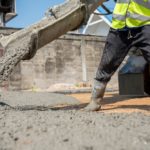Sector - Environment
Embodied carbon – how to cut through the greenwash

The Alliance for Sustainable Building Products (ASBP) – launched by the Sustainable Development Foundation – works at both practical and policy levels to build better, lower carbon-emitting and healthier buildings. ASBP’s director, Simon Corbey, is a chartered surveyor with a master’s in architecture, specialising in advanced energy and environmental systems.
We asked Simon to explain how environmental product declarations (EPDs) are helping builders better understand embodied carbon in construction materials.
EPDs are independently verified by a third-party assessor, ensuring data accuracy.
Manufacturers publishing EPDs have found the process useful because it deepens their knowledge of the embodied carbon in their products and supports innovation and product development to remove emissions hotspots.
- What is an Environmental Product Declaration?
An EPD assesses and standardises the impact of a product’s lifecycle – from manufacture to use, including materials extraction, product manufacturing, energy consumption, transport to site, construction, maintenance and disposal at end-of-life, ie ‘from cradle to grave’.
In Europe, EN 15804 sets the product category rules to ensure consistent reporting of environmental impact information for all construction products. A new and improved +A2 version of the standard will become mandatory in July 2022, with more environmental impact categories and better recognition of biogenic carbon.

What makes up an Environmental Product Declaration?
- Do EPDs have legal ‘teeth’ or are they advisory/best practice?
Currently, the embodied carbon of products is not legislated for in the UK, so EPDs are not mandatory.
The policy focus for the last 50 years has been on operational carbon (ie: carbon emitted from a building’s use). However, as we build ever more efficient buildings, embodied carbon can represent more than 50-70% of a new building’s lifetime emissions. As operational carbon reduces, the impact of embodied carbon increases, which is why we should focus more on embodied carbon.
The impact of the embodied carbon in the products used to build a building is known as the ‘upfront carbon’, as these emissions happen before the building is occupied.
At COP 26, the UK – together with India, Germany and Canada – committed to the Industrial Deep Decarbonisation Initiative to disclose embodied carbon in public construction no later than 2025 and to achieve net zero by 2050.
The UNIDO (United Nations Industrial Development Organisation) is organising working groups on carbon data collection, standards and green public procurement to inform this coalition of governments on the implementation and design of future pledges. ASBP board member Jane Anderson is on this working group.
In the Construction Playbook – the UK Government’s guide for how public works projects and programmes are assessed, procured and delivered – the UK Government states that major publicly-funded projects – eg Highways England, Homes England – will report embodied carbon, but these lack benchmarks or targets.
In the EU, you are not allowed to make any claims relating to your product, unless it is backed up by an independently verified EPD.
- Why is embodied carbon such an important measure?
We are all on a path to net zero whole life carbon, which means we need to reduce the upfront impact of our buildings, now. The embodied carbon of our buildings makes up about 11% of total global carbon emissions, so a considerable chunk of the ‘carbon pie’.
- How can I see how much embodied carbon is in a product?
EN 15804+A1 currently provides seven impact indicators for the product: Global Warming Potential (GWP) relates to greenhouse gases and global warming and includes emissions and removals of both fossil and biogenic carbon. This is the number you need to look for, expressed in tonnes of CO2 equivalent.

EPDs compare products over their lifecycle
- How do you compare EPDs of various products?
It is important to ensure consistency before comparing product EPDs, eg per tonne or per linear metre, and the system’s boundary, ie cradle to grave.
If a product has an EPD, it may be neither low-carbon nor environmentally-friendly.
EPDs are expensive to produce which means smaller manufacturers – eg Thermafleece and Clay Works – have only recently invested in the process and obtained EPDs. Other larger manufacturers, like Medite, recognised the benefit of EPDs a decade ago and have been using them as a tool to aid their drive for greater resource efficiency.
There are tools available on the market to support manufacturers in obtaining EPDs, and the ASBP is launching a licence with some of the key providers of these tools, which will enable its SME member organisations to obtain EPDs at a discounted rate in 2022.
- What’s my top 10 when considering EPDs?
Everything you need to know about EPDs is in this 90-minute video: https://asbp.org.uk/webinar-recording/breaking-down-barriers-to-epd.
In 2022, ASBP will publish a briefing paper on ‘How to Read an EPD’, building upon existing papers on the topic which can be downloaded for free here: https://asbp.org.uk/workstream/environmental-product-declarations.
- When are EPDs coming into force?
This is being considered by the Government’s advisory body – the Environmental Audit Committee. Pressure is building due to the Dept of Business Energy and Industrial Strategy running workshops in Summer 2021 on how embodied carbon can be regulated.
The RICS Professional Statement on Whole Life Carbon is being refreshed to ensure consistency in how we measure the embodied carbon of our buildings.
Simon Sturgis is leading this work and he and colleagues have mocked up a website to show how measurement of embodied carbon could be brought into building regulations. https://part-z.uk/.
- How will EPDs change how we build?
Several organisations – eg RIBA, LETI (the London Energy Transformation Initiative) – have published benchmarks for embodied carbon for buildings and how we might build lower embodied carbon buildings. This means less concrete and steel and more natural materials, which is how the architecture practice, Architype, has been building for the last 30 years.
Architype designed the University of Anglia’s Enterprise Centre, which is an exemplar of a highly energy-efficient, low embodied carbon build. The construction makes use of low carbon cement and structural timber, with straw, thatch and blown cellulose all sequestering carbon.

University of Anglia’s Enterprise Centre – a sustainable exemplar and a healthy building both for its occupants and the planet. Credit: Dennis Gilbert
Tools / Guidance
- There are several tools on the market to assist manufacturers in obtaining an EPD. These include One Click LCA and BRE Lina. ASBP is launching a licence with these tool providers to enable its SME members to obtain discounted EPDs in 2022. Keep up-to-date by signing up to our newsletter at asbp.org.uk/news
- For more guidance on embodied carbon: https://woodknowledge.wales/wkw-resource/hgh-ec-guidance
- The Sustainable Development Foundation (SDF) has developed a library of exemplary high performance buildings, including those with low embodied carbon https://sdfoundation.org.uk/exemplars-library.
All sources included in the above text were accurate as last accessed on: 15 December 2021.
If you would like to read more stories like this, then please click here
Related Articles
More Environment Features
- Government correct to head off Climate and Nature Bill
7 Feb 25
The ‘Climate and Nature Private Members’ Bill’, seeks to set new legally binding targets for climate and nature.
- Biodiversity Net Gain Now in Force – What Does It Mean for You?
12 Jul 24
The UK has significantly advanced by implementing Mandatory Biodiversity Net Gain (BNG) in the ongoing effort to balance development with conservation.
- Building a sustainable built enviornment – On the path to Net Zero
5 Jan 24
How the sector can contribute to the transition to a net zero economy.






